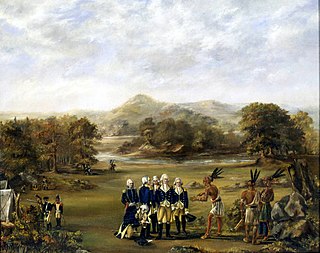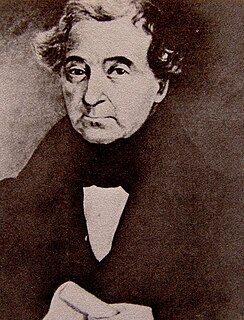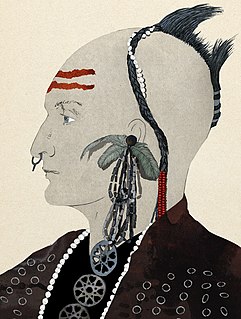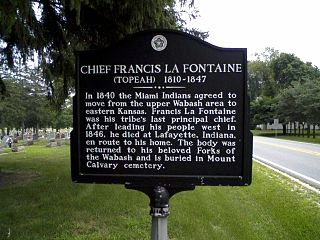Related Research Articles

Little Turtle was a Sagamore (chief) of the Miami people, who became one of the most famous Native American military leaders. Historian Wiley Sword calls him "perhaps the most capable Indian leader then in the Northwest Territory," although he later signed several treaties ceding land, which caused him to lose his leader status during the battles which became a prelude to the War of 1812. In the 1790s, Mihšihkinaahkwa led a confederation of native warriors to several major victories against U.S. forces in the Northwest Indian Wars, sometimes called "Little Turtle's War", particularly St. Clair's defeat in 1791, wherein the confederation defeated General Arthur St. Clair, who lost 900 men in the most decisive loss by the U.S. Army against Native American forces.

The Miami are a Native American nation originally speaking one of the Algonquian languages. Among the peoples known as the Great Lakes tribes, they occupied territory that is now identified as North-central Indiana, southwest Michigan, and western Ohio. The Miami were historically made up of several prominent subgroups, including the Piankeshaw, Wea, Pepikokia, Kilatika, Mengakonkia, and Atchakangouen. In modern times, Miami is used more specifically to refer to the Atchakangouen. By 1846, most of the Miami had been forcefully displaced to Indian Territory. The Miami Tribe of Oklahoma are the federally recognized tribe of Miami Indians in the United States. The Miami Nation of Indiana, a nonprofit organization of descendants of Miamis who were exempted from removal, have unsuccessfully sought separate recognition.

The Chief Jean Baptiste de Richardville House was built near Fort Wayne, Indiana, in 1827. Subsidized by the U.S. federal government through the 1826 Treaty of Mississinewas, it is believed to be one of only three treaty houses built east of the Mississippi River. It was designated a National Historic Landmark on March 2, 2012.

The Wabash and Erie Canal was a shipping canal that linked the Great Lakes to the Ohio River via an artificial waterway. The canal provided traders with access from the Great Lakes all the way to the Gulf of Mexico. Over 460 miles long, it was the longest canal ever built in North America.

Tecumseh's War or Tecumseh's Rebellion was a conflict between the United States and Tecumseh's Confederacy, led by the Shawnee leader Tecumseh in the Indiana Territory. Although the war is often considered to have climaxed with William Henry Harrison's victory at the Battle of Tippecanoe in 1811, Tecumseh's War essentially continued into the War of 1812 and is frequently considered a part of that larger struggle. The war lasted for two more years, until 1813, when Tecumseh and his second-in-command, Roundhead, died fighting Harrison's Army of the Northwest at the Battle of the Thames in Upper Canada, near present-day Chatham, Ontario, and his confederacy disintegrated. Tecumseh's War is viewed by some academic historians as the final conflict of a longer-term military struggle for control of the Great Lakes region of North America, encompassing a number of wars over several generations, referred to as the Sixty Years' War.

The Northwest Indian War (1786–1795), also known by other names, was an armed conflict for control of the Northwest Territory fought between the United States and a united group of Native American nations known today as the Northwestern Confederacy. The United States Army considers it the first of the United States Indian Wars.
Kekionga, also known as Kiskakon or Pacan's Village, was the capital of the Miami tribe. It was located at the confluence of the Saint Joseph and Saint Marys rivers to form the Maumee River on the western edge of the Great Black Swamp in present-day Indiana. Over their respective decades of influence from colonial times to after the American Revolution and Northwest Indian Wars, the French, British and Americans all established trading posts and forts at the large village, as it was located on an important portage connecting Lake Erie to the Wabash and Mississippi rivers. The European-American town of Fort Wayne, Indiana started as a settlement around the American Fort Wayne stockade after the War of 1812.

Jean Baptiste de Richardville, also known as Pinšiwa or Peshewa in the Miami-Illinois language or John Richardville in English, was the last akima 'civil chief' of the Miami people. He began his career in the 1790s as a fur trader who controlled an important portage connecting the Maumee River to the Little River in what became the present-day state of Indiana. Richardville emerged a principal chief in 1816 and remained a leader of the Miamis until his death in 1841. He was a signatory to the Treaty of Greenville (1795), as well as several later treaties between the U.S. government and the Miami people, most notably the Treaty of Fort Wayne (1803), the Treaty of Fort Wayne (1809), the Treaty of Saint Mary's (1818), the Treaty of Mississinewas (1826), the treaty signed at the Forks of the Wabash (1838), and the Treaty of the Wabash (1840).

William Wells, also known as Apekonit, was the son-in-law of Chief Little Turtle of the Miami. He fought for the Miami in the Northwest Indian War. During the course of that war, he became a United States Army officer, and also served in the War of 1812.
Wanagapeth, (?)-1808 was the eldest daughter of Chief Michikinikwa, known as Little Turtle. She married Apekonit, or Capt. William Wells.

Fort Wayne was a series of three successive military log stockades existing between 1794 and 1819 in the Miami Indian village of Kekionga, on the portage between the St. Mary's and St. Joseph Rivers in northeastern Indiana, in what is now the city of Fort Wayne.
Charles Beaubien was a French Canadian trader in the 18th century who became British Agent to the Miami Nation.

Pacanne was a leading Miami chief during the late 18th and early 19th centuries. Son of The Turtle (Aquenackqua), he was the brother of Tacumwah, who was the mother of Chief Jean Baptiste Richardville. Their family owned and controlled the Long Portage, an 8-mile strip of land between the Maumee and Wabash Rivers used by traders travelling between Canada and Louisiana. As such, they were one of the most influential families of Kekionga.
Nagohquangogh, was a chief of the Pepikokia band of the Miami tribe in the 18th century. Also known as The Gray, he was one of three important Miami leaders during the Northwest Indian War, along with Pacanne and Little Turtle.

Francis La Fontaine, or Topeah or Me-Shine-go-me-she-a, was the last principal chief of the unified Miami tribe, and oversaw the split into the Western and Eastern Miami tribes.

The Harmar campaign was an Autumn 1790 attempt by the United States to subdue confederated Native Americans nations in the Northwest Territory that were seen as hostile. The campaign was led by General Josiah Harmar, and is considered a significant campaign of the Northwest Indian War. The campaign ended with a series of battles from 19–21 October 1790 near the Miami villages of Kekionga. These were all overwhelming victories for the Native Americans, and are sometimes collectively referred to as Harmar's Defeat.
Five Medals was a leader of the Elkhart River Potawatomi. He led his people in defense of their homelands and was a proponent of agriculture. Five Medals first appeared in eastern records after the Battle of Fallen Timbers, but disappears from those records shortly after the end of the War of 1812.

The Treaty of Grouseland was an agreement negotiated by Governor William Henry Harrison of the Indiana Territory on behalf of the government of the United States of America with Native American leaders, including Little Turtle and Buckongahelas, for lands in Southern Indiana, northeast Indiana, and northwestern Ohio. The treaty was negotiated and signed on Aug 21, 1805, at Harrison's home in Vincennes, Indiana, called Grouseland. Negotiated a year after the second Treaty of Vincennes, it was the second major land purchase in Indiana since the close of the Northwest Indian War and the signing of the 1795 Treaty of Greenville.
Cold Foot was a Miami chief in the 18th century; his brother or brother-in-law was The Turtle (Aquenackqua), father of Cold Foot's nephew, P'koum-kwa and of P'koum-kwa's sister, Tacumwah, who became the wife of a French fur trader and the mother of Chief Peshewa. Their family owned and controlled the Long Portage, an 8-mile strip of land between the Maumee and Wabash Rivers used by traders travelling between Canada and Louisiana. An inhabitant of Kekionga, Cold Foot lived during a time when the Miami were torn between their traditional trading partners of New France and new, more lucrative traders from the British colonies. There is a record of Cold Foot receiving a large reward for putting down some hostilities during this time.

During the War of 1812, Indiana Territory was home to several conflicts between the United States territorial government and partisan Native American forces backed by the British in Canada. The Battle of Tippecanoe, which had occurred just months before the war began, was one of the catalysts that caused the war. The war in the territory is often considered a continuation of Tecumseh's War, and the final struggle of the Sixty Years' War.
References
- ↑ Winger, Otho (1935). "A Pioneer Experiment in Teaching Agriculture". The Last of the Miamis . p. 5.
- ↑ Carter, pg 199
- ↑ Anson, pg 151
- ↑ Poinsatte, 45-46
- ↑ see Hopkins' report
- ↑ Carter, 208 fn10, says Dennis' Station is four miles east of Lagro, Indiana, near the Richardville House.
- ↑ Carter, 200-202.
- ↑ Thornbrough, pg 18-19